#and though it is emotionally fraught and currently fighting me I am still very happy to be getting back to my beloved Guard
Text
✨⚡️ Seven(ish) Sentence Sunday ⚡️✨
Tagged by @acountrygirlsfun (a couple times by now, though not actually this most recent time, but I figure it still counts!) Thank you, Caitlin <3 <3 <3
Helix took a deep breath in, counted four flashes of the desperate direct-@ lights coming in from his side chat panels, and breathed out. His voice came out steady, and miraculously casual.
"We understand why you did it. You were trying to keep our brothers safe."
He watched Harp's eyes go wide at the 'our' brothers. Like he hadn't expected the rest of them to claim the Corries. Because he'd been hiding from them just like from the longnecks, he had falsified his—
Deep breath in. Two flashes, no time for longer, leave no silence for Harp to panic in. Breathe out. Keep going.
This is not seven sentences, but it's also largely not complete sentences anyway, and it is literally what I just seconds ago finished writing. Still counts!
No-pressure tagging uhhh @ialpiriel, @goingsparebutwithprecision, @anaclastic-azurite, anybody else who might want to play?
#tagged by#acountrygirlsfun#I should be taking a shower and going to sleep but this scene isn't clicking so rather than getting frustrated I'm posting it here#I will have to go back through in my rewrites later and make sure everyone doesn't have their breakdowns in the same way#I do a bit better when the characters are speaking out loud#but for internal thought processes I tend to end up with them all sounding suspiciously similar to my own. whoops#anyway this is more of the good data management AU! we've just learned that the Corrie Guards Are Not Okay#and now most everybody else is also Not Okay! we're having bad times today folks#in the story I mean. I had a fine day!#and though it is emotionally fraught and currently fighting me I am still very happy to be getting back to my beloved Guard#Harp's a medic OC and I adore him and he and the Guard he's trying so hard to take care of really deserve a break#and now their brothers are a little more aware (seriously they have only just nicked the tippest bit of iceberg) of how not okay they are#a break they shall shortly receive!!#(it's gonna come with a double helping of Bother so they won't be very grateful. but they will be better rested and that's what matters)
8 notes
·
View notes
Text
Close reading all the Jin Guangyao scenes: episode 24
Episode 10 | Episode 11 | Episode 22 | Episode 23
The title of this is a lie, actually, since the first half? two thirds? of this is going to be finishing up with episode 23, but ah well.
So, I left off with the previous episode right after the deeply unfortunate clusterfuck of a conversation between Jin Guangyao, Lan Xichen, Nie Mingjue, and Jin Guangshan, followed by “sometimes war crimes can double as grooming your extremely emotionally vulnerable son, and that’s terrible”. Which means now, it’s time for…

Swearing an (extremely ill-advised) oath of holy fratrimony!
This is a bit of speculation, since we see almost no detail on what went into the decision to become sworn brothers, but my read is that it at least partially reflects a political motive – tying prominent members of three clans together, rebuilding the rather demolished state of firm alliances and power left in the wake of a major war – while also reflecting a personal desire I think on Lan Xichen’s part to repair the rift between his two good friends, and offer them each a promise that they won’t be left isolated in the middle of larger forces trying to break them down.
The political aspect becomes a bit more apparent when considering the wording of the oath itself, actually: “We are liable to the immortal sects. We are to bring peace and stability to the commoners… If there is a change of heart, one will be faced with a thousand accusing fingers, and the wrath of Heaven and men!” – While this reflects a shared set of values, certainly, it also strikes me as relevant that these three, two of them current sect leaders, are swearing essentially not to become like the Wen clan that they’ve just deposed: they’ll be accountable to others, they’ll work for the benefit of those living under their authority, rather than capriciously throwing their weight around for personal gain.
Oh, and also - I’ve mentioned before, the dramatic irony here in how the consequences they invoke for failing to uphold the principles of their sworn brotherhood are in fact exactly what happens to Jin Guangyao in the end – given what’s to come, the oath he’s swearing ends up being more like a curse. Don’t swear oaths, kids, it never works out well. Of course, at the time, I don’t think he has any intention at all of betraying those principles – the “bring peace and stability to the commoners” part is certainly something he makes an effort to follow up on, once he has the power to do so! Still, for something that starts out with an explicit declaration to not be the sort of evil that Nie Mingjue so straightforwardly abhors, it’s… a very sad outcome.
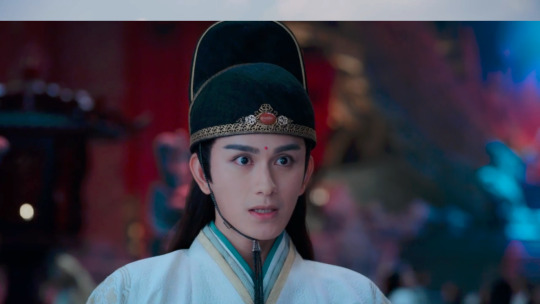
Moving forward, we have… the most awkward set of greetings in the entire world, I swear. Mingjue shows up to the post-victory banquet and gets offered the world’s most politically-fraught location on the seating chart; Lan Xichen then reminds Jin Guangyao in front of the assembled members of three(!) separate sects to call him da-ge instead of Chifeng-zun. Jin Guangyao redoes his greeting/offer with the most intense deer-in-headlights look (pictured above), pretty clearly aware that Mingjue is not about to be happy with him. (This little exchange, including the encouraging nod also from LXC to NMJ, is further evidence beyond simply their general personalities I think, that Xichen was the driving force behind the brotherhood oath, especially in a personal sense.) But also, it serves as another piece of foreshadowing future events: knowing Mingjue is unlikely to be happy with the offer of Wen Ruohan’s old throne, Jin Guangshan hands the actual task of offering it off to Jin Guangyao. Here at least, Mingjue doesn’t get distracted from who’s really behind the offer, and addresses Jin Guangshan in vehemently refusing the seat; but it nonetheless continues establishing the pattern where JGS uses Jin Guangyao to be the primary face of his own less-than-savory political maneuvering.
(Which in general, makes me think it’s kind of interesting that he does have Jin Guangyao there greeting guests with him in the first place, and not Jin Zixuan? It’s a bit difficult for me to read what the status of co-greeter is supposed to be – second-in-command, or glorified servant? I think there may be a little bit of both, if JGY is there on one hand because he was the one setting the banquet up, but on the other hand also, because JGS wants to parade him around as his very own hero of the Sunshot Campaign, as Sect Leader Yao is so kind to remind us.
And then there’s... the one-on-one chat with Wei Wuxian.

First off, I’d like to link people to this post by @hunxi-guilai, which honestly just goes over… a lot of what I probably would have liked to say about the implied meanings in this conversation. Essentially: Wei Wuxian is interested in what’s going on with this other Sunshot hero who also seems to be not carrying any sword (in a scene where we even see Jiang Yanli carrying hers!), and who had previously used a somewhat unorthodox weapon for his Wen Ruohan stabbing. Jin Guangyao though, is… not really interested in drawing attention to either of those facts (and I’m sure not in a way that would see him in solidarity with WWX), considering “unorthodox and outside the standard set of accepted behaviours in cultivator society” is the opposite of what he’s trying to look like right now.
Relevant to this, honestly, is the question of “what the fuck exactly even is a soft sword,” which CQL does approximately nothing to explain on the face of it, and only very implicitly does so if you’re obsessive like me and try to take blurry screenshots to compare the sword we see stabbing WRH with the sword that Jin Guangyao uses when fighting WWX’s paperman in episode 41.

Which do appear to be the same sword, inability to get a good clear look at it in either context notwithstanding. Oh, and JGY seems to have either repainted or swapped out the hilt, at some point in the intervening years – perhaps to better match the Jin clan’s aesthetic of white & gold sword decoration that we see on Jin Zixuan’s Suihua?
Anyway, for context on the “what’s a soft sword” issue, I am going to quote a relevant portion from the (EXR translation of the) MDZS novel, even though in general I’m trying to keep the canon cross-pollination in these meta to a minimum.
Back then, when Jin GuangYao worked undercover at Wen RuoHan’s side, he had often hidden the sword at his waist, wreathed the sword around his arm to use during critical moments. Although the blade of Hensheng seemed to be soft to the extremity, attacking with lingering motions, it was in reality both sharp and haunting. Once the blade had wrapped around the opposition, Jin GuangYao would apply it with a bizarre spiritual power, and one would quickly be severed into pieces by the sword, despite its tender appearance. Quite a few famous swords had been battered into piles of scrap iron just like this. At the moment, the blade of the sword attacked as though it was a serpent with silver scales, biting at the paperman without any hesitation.
So yeah – it’s an uncommon weapon, a sword with a blade that can bend and thus works very well for things like being sneaky and unassuming, and not fighting “fairly” in a way the vast majority of other cultivators would have any experience countering.
And... oh my god. Now we’re finally onto episode 24 properly.
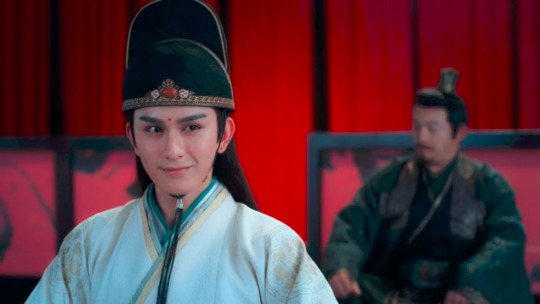
The first input we get from Jin Guangyao this episode is this charming smirk as Wei Wuxian walks up into the center of the hall to interrupt JGS’s unpleasant “hey let’s renew this betrothal~” play. Personal amusement about a rather dramatic individual showing up to do something undoubtedly also dramatic? Entertainment about how a person not known for his skill at subtle political maneuvering is probably about to come in and make a mess that the Jin clan will be able to spin to their own advantage? Ehhh, why not both?
Though of course, the Jiang clan members function very well as a unit here once Wei Wuxian comes in to shake things up, and it’s not nearly the uncomplicated win for the Jin clan that he was probably expecting. Meanwhile, once that’s over, he takes the next opportunity to introduce his father’s next order of business, the invitation to the Phoenix Mountain hunt - and in fact, he does so with an absolutely seamless transition from Jiang Yanli’s rejection of the proposed marriage plan renewal:
“Everyone. For the previous Clan Leader Jiang to have such a daughter is already a great comfort to his soul. And not just Jiang Clan, but after the mess with the Wen Clan, every clan has experienced losses. This is a crucial time for us to rebuild and we critically are in need of manpower. For the past days, Father has spent a lot of time pondering over this matter. Luckily, he’s found a countermeasure. I dare to represent my father in inviting everyone back to Jinlintai during the fall. Jin clan will be putting all efforts towards reorganizing the round-up and hunting event at Hundred Phoenixes Mountain.”
It’s easy to overlook, I think, but the amount of rhetorical skill to put that together on the fly? It’s really not for nothing that Meng Yao was first introduced as being impressively sharp and well-spoken. He’s taking what starts as a loss of face for the Jin clan, redirecting it to focus on the virtue of Jiang Yanli, and then tying that in to the losses and worries that every sect now has in the wake of the war ending. And having reminded them of their own interests and present worries here, he steps in to offer a solution that slots the Jin clan in back at the top, looking extremely good, due to the wealth and comparative manpower advantage they have over everyone else after entering the war relatively late.
(Also, to clarify since it’s only ever implied rather than stated outright in the show, via the dialogue here and then another piece during the hunt itself – the Hundred Phoenix Mountain hunt, from what I can tell, is a regular event held for the purpose of showing off each clan’s skills so that they can attract new prospective disciples, hence why it’s a solution to the sects’ manpower being depleted by the war. Additionally, given the use in particular of reorganizing the event, I’m going to go out on a limb and guess that ordinarily, this event would be one put on by the Chief Cultivator. So with the Wen sect demolished, there was nobody readily available to step up and take over handling this event until now. Jin Guangshan may be fooling none of the viewers about his intentions in adopting a seat right next to Wen Ruohan’s old chair, but he’s certainly making good use of a-Yao’s rhetorical talent to get yet another instance of stepping into the role vacated by the Wen sect looked upon as praiseworthy benevolence.)
…And then what thanks does he get for it? Some dispassionate praise, more work, and no appreciation for the tea he’s made.
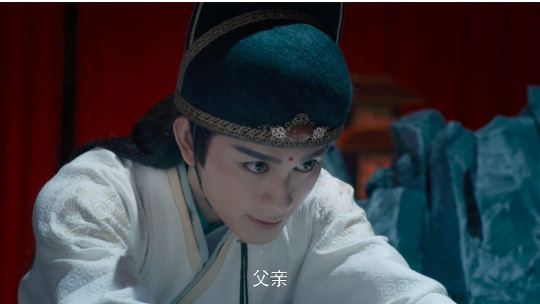
It’s a bit telling (and painful) the way he responds to being asked if he’s found the location of the Yin metal yet, also: “Not yet; I’m incompetent.” I think he’s definitely the sort to feel, even as he’s very aware of the worth of his skills and what sort of areas he’s good with in some respects, the foundation of his belief in himself is nonetheless incredibly rocky and it’s easy for a reminder of any sort of failure to loom suddenly very large over his self-assessment in the moment.
At the same time though, Jin Guangyao is very much an adaptable person, and we see that on full display with his next explanation: that the one who has the last piece of Yin metal may very likely be Wei Wuxian. It’s both an exercise in political savvy, pointing out a powerful and disruptive influence likely to cause problems for Jin Guangshan in the future if his interference in the marriage proposal is any indication, and a significant sewing together of information from several different sources: Wei Wuxian’s opportunity to be in the same place previously as Xue Yang, as he explains to JGS, but also the front-row seat for WWX interfering with the power of Wen Ruohan’s Yin metal using Chenqing and his new Yin Tiger Seal.
I don’t think he holds any particular animosity toward Wei Wuxian at this point? This reads to me like a calculation based pretty essentially on: his father is clearly invested in expanding the power of the Jin sect and diminishing the interest or ability of other sects to oppose him, and also in (instrumentally to that goal) getting his hands on the last piece of Yin metal. Jin Guangyao has been explicitly tasked with working on the latter concern, and probably implicitly at least with the former - at some point, and some point soon, he’s going to need to produce results on that front, or else be dropped from JGS’s incredibly conditional regard for not being useful enough. Given the confluence of circumstances, lining up suspicions (which for all he knows are likely even true!) against Wei Wuxian serves both goals, and gives him another safe place to rest for a day or two before having to continue worrying how to be helpful enough to keep deserving his newfound status.
And that’s it for Jin Guangyao in episode 24! Poor kiddo. Looks like you can climb another rung higher on the ladder, sure, but it doesn’t mean you’ll make it free of being used for quite a long while still.
#no good things for the poor sad cultivators#The Untamed#Jin Guangyao#meta#I think these are getting longer... send help....#also: I lost my shit a little when I realised all those details I noted about the Phoenix Mountain hunting event#JGS is... such a master of political maneuvering. I hate it.#rambling
96 notes
·
View notes
Video
youtube
The newest installment of The Alt-Right Playbook - Endnote 4: How the Alt-Right is Like an Abusive Relationship - is a little different. This installment was presented live at Solidarity Lowell, and includes a bonus Q&A section. This video expands on the ideas put forth in How to Radicalize a Normie.
If you would like more videos like this to come out, please back me on Patreon.
Transcript below the cut.
He is intriguing, yet unpredictable. He demands unconditional loyalty. He seems to have an intuitive understanding of what people want to hear but no actual empathy; he treats others as simply bodies or objects. And he’s surrounded by a network of subordinates but the personnel is always changing.
Does it sound like I’m describing The President? Because these are, according to Alexandra Stein, qualities of a cult leader.
Hi. My name is Ian Danskin. I’m a video essayist and media artist. I run the YouTube channel Innuendo Studios, the flagship endeavor of which is currently The Alt-Right Playbook, a series on the political and rhetorical strategies the Alt-Right uses to legitimize itself and gain power. And, if that sounds interesting to you, and you haven’t already, please like share and subscribe.
The most recent episode of The Alt-Right Playbook is about how people get recruited into these largely online reactionary communities like the Alt-Right, a subject which, as it turns out, is real fuckin’ hard to research.
What I want to talk about with you today is how I go about studying a population that is incredibly hostile towards being studied. It involves finding the bits and pieces of the Alt-Right that we do have data on - the pockets of good research, the outsider observations, the stories of lived experience - as well as looking at older movements the Alt-Right grew out of, that have been extensively researched, and spotting the ways the Alt-Right is continuous with them, and trying to extrapolate how those structures might recreate themselves in the social media age.
So it’s… a lot. And, in the process of researching, I found a wealth of interesting perspectives that, by focusing the video on recruitment specifically, I barely dipped a toe in. All that stuff is what I’d like to get into with you today. But I’m trying to thread a needle here: you don’t need to have seen my video, How to Radicalize a Normie, to follow this talk, but, if you have seen it already, I will try not to be redundant. This talk is one part making my case for why I think the conclusions in that video are correct, one part repository for all the stuff I couldn’t get into, and one part how I’ve come to look at the Alt-Right as a result of this research, including some pet theories I wouldn’t feel right claiming as truth without further research, but I do think are on the right track.
This talk is called Isolation, Engulfment, and Pain: How the Alt-Right is Like an Abusive Relationship. We’re going to cover a lot of ground, from information processing to emotional development, but we’re necessarily also going to cover racism and violence and abuse dynamics. So this is an introduction and a content warning: if some of these subjects are particularly charged for you, no offense will be taken if you at any point leave the room. I have to research this stuff for a living, and it is rough, and sometimes I have to step away. We don’t judge here.
Now. Requisite dash of self-deprecation: don’t give me too much credit for all this. I am proud of the work I do and I think I’m genuinely good at it, but much of this video was compiling the work of others. Besides research I had already done and my own observations, the video had 27 sources: three books, five research papers, six articles, one leaked document, three testimonials, four videos, four pages of statistics, and one Twitter joke. I also spoke to four professional researchers who study right-wing extremism and one former Alt-Righter.
Without all their hard work, I would have nothing to compile.
OK? Let’s begin.
We’re gonna center on those three main texts: Alt-America by David Neiwert, a history of the Alt-Right’s origins; Healing from Hate by Michael Kimmel, about how young men get into (and out of) extremist groups, be they neo-Nazi or jihadist; and Terror, Love and Brainwashing by Alexandra Stein, about how people are courted by and kept inside cults and totalitarian regimes.
I began with Kimmel. The premise of Healing from Hate is that extremist groups tend to be between 75 and 90% male, and that you cannot understand radical conservatism without looking at it through the lens of toxic masculinity. Which makes it all the more disappointing that Kimmel has been accused by multiple women of bullying and harassment. I found the book incredibly useful, and we’re still going to talk about it, I just need to caveat here that retweets are not endorsements. Also, if I spoil the book for you then you don’t need to buy it, give your money to someone who isn’t a creep.
Kimmel’s argument is that extremism begins with a pain peculiar to young men. He calls it “aggrieved entitlement.” I call it Durden Syndrome. You know that scene in Fight Club where Tyler Durden says, “We’ve all been raised on television to believe that one day we’d all be millionaires and movie gods and rockstars, but we won’t, we’re slowly learning that fact, and we are very, very pissed off”? Yeah, that. As men, the world promised us something, and the promise wasn’t kept.
Some men skew towards social progressivism when they realize this promise was never made to women, or men of color, or queer or trans or nonbinary people, and recognize the injustice of that. Some men skew towards economic leftism when they realize that every cishet white man being a millionaire rockstar movie god is mathematically impossible. But they skew towards reactionary conservatism when they feel the promise should have been kept. That’s the life they were supposed to have, and someone took it from them.
Hate groups appeal to that sense of emasculation. “You wanna feel like a Real Man? Shave off your hair, dance to hatecore, and let’s beat the crap out of someone.” Kimmel notes that the greatest indicator someone will join a hate group is a broken home: divorce, foster care, parents with addictions, physical or sexual abuse. The greater the distance between the life they were promised and the life they are living, the more enticing Real Masculinity becomes. Their fellow extremists are brothers, the leaders father figures.
The group does give them someone to blame for their lot in life - immigrants, feminists, the Jewish conspiracy - but that’s not why they join. They’re after empowerment. According to Kimmel, “Their embrace of neo-Nazi ideology is a consequence of their recruitment and indoctrination process, not its cause."
But once an Other has been identified as the locus of a hate group’s hate, new recruits are brought along when the group terrorizes that Other. Events like cross burnings and street fights are dangerous and morally fraught, and are often traumatic for a new recruit. And experiencing an emotional or physical trauma can create an intense bond with the people experiencing it with him, even though they’re the ones who brought him to the traumatic event in the first place. The creation of this bond is one of the reasons some hate groups usher new recruits out into the field as early as possible: the sooner they are emotionally invested in the community, the faster they will embrace the community’s politics.
This Othering also estranges recruits from the people they are supposed to hate, which makes it hard to stop hating them.
So there’s this concept that comes up a lot in my research called Contact Hypothesis. Contact Hypothesis argues that, the more contact you have with a different walk of life, the easier it is to tolerate it. It’s like exposure therapy. We talk about how big cities and college campuses tend to be liberal strongholds; the Right likes to claim this is because of professors and politicians poisoning your mind, but it’s really just because they’re diverse. When you share space with a lot of different kinds of people, a degree of liberalism becomes necessary just to get by. And we see that belief systems which rely on a strict orthodoxy get really cagey about members having contact with outsiders. We see this in all the groups we’re discussing today - extremists, cultists, totalitarians - but also religious fundamentalists; Mormons only wanna send their kids to Brigham Young. They are belief systems that can only be reliably maintained so long as no one gets exposed to other people with other beliefs.
So that’s some of what I took from Kimmel. Next I read Stein talking, primarily, about cults.
Stein’s window into all of this is applying the theory of Attachment Styles to what researchers calls totalism, which is any structure that subsumes a person’s entire life the way cults and totalitarian governments do. Attachment is a concept you may be familiar with if have, or have ever dated, a therapist. (I’ve done both.)
So, for a quick primer:
Imagine you’re walking in the park with a three-year-old. And the three-year-old sees a dog, and ask, “Can I pet the dog?” And you say yes, and the kid steps away from your side and reaches out. And the dog gets excited, and jumps up, and the kid gets scared and runs back to you. So you hold the kid and go, “Oh, no no no, don’t worry! They’re not gonna hurt you! They were just happy to see you!” And you take a few moments to calm the kid down, and then you ask, “Do you still want to pet the dog?” And the kid says “yes,” so they step away from you again and reach out. The dog jumps up again, but this time the kid doesn’t run away, and they pet the dog, and you, the kid, and the dog are all happy. Hooray!
This is a fundamental piece of a child’s emotional development. They take a risk, have a negative experience, and retreat to a point of comfort. Then, having received that comfort, feel bolstered enough to take a slightly greater risk. A healthy childhood is steadily venturing further and further from that point of comfort, and taking on greater risks, secure in the knowledge that safety is there when they need it. And, as an adult, they will form many interdependent points of comfort rather than relying on only one or two.
If all goes according to plan, that is Secure Attachment. But: sometimes things go wrong when the kid seeks comfort and doesn’t get enough. This may be because the adult is withholding or the kid doesn’t know how to express their needs or they’re just particularly fearful. But the kid may start seeking comfort more than seems reasonable, and be particularly averse to risk, and over-focus on the people who give them comfort, because they’re operating at a deficit. We call that Anxious Attachment. Alternately, the kid may give up on receiving comfort altogether, even though they still need it, and just go it alone, developing a distrust of other people and a fear of being vulnerable. We call that Avoidant Attachment.
Now, these styles are all formed in early childhood, but Stein focuses on a fourth kind of Attachment, one that can be formed at any age regardless of the Attachment Style you came in with. It’s what happens when the negative experience and the comfort come from the same place. We see it in children and adults who are mistreated by the people they trust. It’s called Disorganized Attachment.
According to Stein, cults foster Disorganized Attachment by being intensely unpredictable. In a cult, you may be praised for your commitment on Monday and have your commitment questioned on Tuesday, with no change in behavior. You may be assigned a romantic partner, who may, at any point, be taken away, assigned to someone else. Your children may be taken from you to be raised by a different family. You may be told the cult leader wants to sleep with you, which may make you incredibly happy or be terrifying, but you won’t be given a choice. And the rules you are expected to follow will be rewritten without warning.
This creates a kind of emotional chaos, where you can’t predict when you will be given good feelings and when you will be given bad ones. But you’re so enmeshed in the community you have noplace else to go for good feelings; hurting you just draws you in deeper, because they are also where you seek comfort. And your pain is always your fault: you wouldn’t feel so shitty if you were more committed. Trying to make sense of this causes so much confusion and anguish that you eventually just stop thinking for yourself. These are the rules now? OK. He’s not my brother anymore? OK. This is my life now? OK.
Hardly anyone would seek out such a dynamic, which is why cults present as religions, political activists, and therapy groups; things people in questioning phases of their lives are liable to seek out, and then they fall down the rabbit hole before they know what’s happening. The cult slowly consumes more and more of a recruit’s life, and tightly controls access to relationships outside the cult, because the biggest threat to a Disorganized Attachment relationship is having separate, Securely Attached points of comfort.
And at this point I said, “Hold up. You’re telling me cults recruit by offering people community and purpose in times of need, become the focal point of their entire lives, estrange them from all outside perspectives, and then cause emotional distress that paradoxically makes them more committed because they have nowhere else to go for support?”
Isn’t that exactly how Kimmel described joining a hate group?
Now, these are commonalities, not a one-to-one comparison. A cult is far more organized and rigidly controlled than a hate group. But Stein points out that this dynamic of isolation, engulfment, and pain is the same dynamic as an abusive relationship. The difference is just scale. A cult is functionally a single person having a very complex domestic abuse situation with a whole lot of people, #badpolyamory.
So if we posit a spectrum with domestic abuse on one end and cults and totalitarianism on the other, I started wondering, could we put extremist groups, like ISIS and Aryan Nations, around… here?
And, if so, where would we put the Alt-Right?
Now, I have to tread carefully here. There are reasons this talk is called “How the Alt-Right is Like an Abusive Relationship” and not “How the Alt-Right is Like a Cult,” because the moment you say the second thing, a lot of people stop listening to you. Our conception of cults and totalitarianism is way more controlled and structured than a pack of loud, racist assholes on the internet. But we’re not talking about organizational structure, we’re talking about a relationship, an emotional dynamic Stein calls “anxious dependency,” which fosters an irrational loyalty to people who are bad for you and gets you to adopt an ideology you would have previously rejected. (I would also love to go on a rant puncturing the idea that cultists and fascists are organized, pointing out this notion is propaganda and their systems are notoriously corrupt and mismanaged, but we don’t have time; ask me about it in the Q&A if you want me to go off.)
So I started looking through what I knew, and what I could find, about the Alt-Right to see if I could spot this same pattern of isolation, engulfment, and pain online funneling people towards the Alt-Right. And I did not come up short.
Isolation? Well, the Alt-Right traffics in all the same dehumanizing narratives about their enemies as Kimmel’s hate groups - like, the worst things you can imagine a human being saying about a group of people are said every day in these forums. They often berate and harass each other for any perceived sympathy towards The Other Side. They also regularly harass people from The Other Side off of platforms, and falsely report their tweets, posts, and videos as terrorism to get them taken down. (This has happened to me, incidentally.) I found figureheads adored by the Alt-Right who expressly tell people to cut ties with liberal family members.
We talked before about Contact Hypothesis? There’s also this idea called Parasocial Contact Hypothesis. A parasocial relationship is a strong emotional connection that only goes one way, like if you really love my videos and have started thinking of me almost as a friend even though I don’t know you exist? Yeah. Parasocial relationship. They’ve been in The Discourse lately, largely thanks to my friend Shannon Strucci making a really great video about them (check it out, I make a cameo, but… clear your schedule). Parasocial Contact Hypothesis is this phenomenon where, if people form parasocial feelings for public figures or even fictional characters, and those people happen to be Black, white audience members become less racist similar to how they would if they had Black friends. Your logical brain knows that these are strangers, but your lizard brain doesn’t know the difference between empathy for a queer friend and empathy for a queer character in a video game. So of course the Alt-Right makes a big stink about queer characters in video games, and leads boycotts against “forced diversity,” because diverse media is bad for recruitment.
Engulfment? Well, I learned way too much about how the Alt-Right will overtake your entire internet life. There was a paper made the rounds last year by Rebecca Lewis charting the interconnectedness of conservative YouTube. (Reactionaries really hated this paper because it said things they didn’t like.) Lewis argues that, once you enter what she calls the Alternative Influence Network, it tends to keep you inside it. Start with some YouTuber conservatives like but who’s branded as a moderate, or even a “classic liberal.” Take someone like Dave Rubin; call Dave Rubin Alt-Right, people yell at you, I speak from experience. Well, Dave Rubin’s had Jordan Peterson on his show, so, if you watch Rubin, Peterson ends up in your recommendations. Peterson has been on the Joe Rogan show, so, you watch Peterson, Rogan ends up in your recommendations. And Rogan has interviewed Gavin McInnes, so you watch Rogan and McInnes ends up in your recommendations.
Gavin McInnes is the head of the Proud Boys, a self-described “western chauvinist” organization that’s mostly known for beating up liberals and leftists. They have ties to neo-fascist groups like Identity Evropa and neo-fascist militias like the Oath Keepers, they run security for white nationalists, and their lawyer just went on record that he identifies as a fascist. And, if you’re one of these kids who has YouTube in the background with autoplay on, and you’re watching Dave Rubin? You might be as few as 3 videos away from watching Gavin McInnes.
There’s a lot of talk these days about algorithms funneling people towards the Right, and that’s not wrong, but it’s an oversimplification. The real problem is that the Right knows how to hijack an algorithm.
I also learned about the Curation/Search Radicalization Spiral from a piece by Mike Caulfield. Caulfiend uses the horrific example of Dylann Roof. You remember him? He shot up a church in a Black neighborhood a few years ago. Roof says he was radicalized when he googled “Black on white crime” and saw the results. Now, if you search the phrase “crime statistics by demographic,” you will find fairly nonpartisan results that show most crimes are committed against members of the perpetrator’s own race, and Black people commit crimes against white people at about the same rate as any other two demographics. But that specific phrase, “Black on white crime,” is used almost exclusively by white racists, and so Roof’s first hit wasn’t a database of crime statistics, it was the Council of Conservative Citizens. Now, the CCC is an outgrowth of the White Citizens Councils of the 50’s and 60’s which rebranded in ‘85. They publish bogus statistics that paint Black people as uniquely violent. And they introduce a number of other politically-loaded phrases - like, say, “Muslim fertility rates” - that nonpartisan sites don’t use, and so, if Roof googles them as well, he gets similarly weighted results.
I have tons more examples of this stuff. I literally don’t have time to show it all. Like, have you heard of Google bombing? That’s a thing I didn’t know existed. The point is, the same way search engines tailor your results to what they think you want, once you scratch the surface of the Alt-Right they are highly adept at making it so, whenever you go online, their version of reality is all you know and all you see.
Finally, pain. This was the difficult one. Can you create a Disorganized Attachment relationship over the internet with a largely faceless and decentralized movement? I pitched the idea to one the researchers I spoke to, and he said, “That sounds very plausible, and nearly impossible to research.” See, cults and hate groups? They don’t wanna talk to researchers anymore than the Alt-Right wants to talk to me. Stein and Kimmel get their data by speaking to formers, people who’ve exited these movements and are all too happy to share how horrible they were. But the Alt-Right is still very young, and there just aren’t that many formers yet.
I found some testimonials, and they mostly back up my hypothesis, but there’s not enough that I could call them statistically significant. So I had to look where the data was.
My fellow YouTuber ContraPoints made a video last year - in my opinion, her best one - about incels (that’s “involuntary celibate,” men who can’t get laid). Incel forums tend to be deeply misogynistic and antifeminist, and have a high overlap with the Alt-Right. If you remember Elliot Rodger, he was an incel. Contra’s observation was that these forums were incredibly fatalistic: you are too ugly and women too shallow for you to ever have sex, so you should give up. She described a certain catharsis, like picking a really painful scab, in hearing other people voice your worst fears. But there was no uplift; these communities seemed to have a zero-tolerance policy for optimism. She likened it so some deeply unhealthy trans forums she used to visit, where people wallowed in their own dysphoria.
And I remembered the forums I researched five years ago in preparation for my video on GamerGate. (If you don’t know what GamerGate was, I will not rob you of your precious innocence. But, in a lot of ways, GamerGate was the trial run for what the Alt-Right has become.) These forums were full of angry guys surrounding themselves with people saying, “You’re right to be angry.” And, yeah, if everywhere else you go treats your anger as invalid, that scratches an itch. But I never saw any of them calm down. They came in angry and they came out angrier. And most didn’t have anywhere else to vent, so they all came back.
I found a paper on Alt-Right forums that described a similar type of nihilism, and another on 8chan. What humor was on these sites was always shocking, furiously punching down, and deeply self-referential, but it didn’t seem like anyone was expected to laugh anymore, just, you know, catch the reference. I found one testimonial saying that having healthy relationships in these spaces is functionally impossible, and the one former I talked to said, yeah, when the Alt-Right isn’t winning everyone’s miserable.
So I think it might fit. The place they go for relief also makes them unhappy, so they come back to get relief again, and it just repeats. Same reason people stay with abusers. I wanna look into this further, so, I’ll just say this part to the camera: if there are any researchers watching who wanna study this, get at me.
Finally, I read Alt-America by David Neiwert, a supremely useful book that I highly recommend if you wanna know how the Alt-Right is the natural outgrowth of the militia and Patriot movements of the 90’s and early 2000’s, not to mention the Tea Party. Neiwert also does an excellent job illustrating how conspiracism serves to fill in the gap between the complexity of the modern world and the simplistic, might-makes-right worldview of fascism.
Neiwert also provides an interesting piece of the puzzle, suggesting what people are actually looking for when they get recruited. He references work done by John Bargh and Katelyn McKenna on Identity Demarginalization. Bargh and McKenna looked at the internet habits of people whose identities are both devalued in our society and invisible. By invisible, what I mean is, ok, if you’re a person of color, our society devalues your identity, but you can look around a room and, within a certain margin of error, see who else is POC, and form community with them if you wish. But, if you’re queer, you can’t see who else in a room is queer unless one of you runs up a flag. And revealing yourself always means taking on a certain amount of risk that you’ve misread the signals, that the person you reveal yourself to is not only not queer, but a homophobe.
According to Bargh and McKenna, people in this situation are much more likely to seek online spaces that self-select for that identity. A fan forum for RuPaul’s Drag Race is maybe a safer place to come out and find community. And people tend to get very emotionally tied to these online spaces where they can be themselves.
Neiwert points out that the same phenomenon happens among privileged people who have identities that are devalued even as they’re not actually oppressed. Say, nerds, or conservatives in liberal towns, or men who don’t fit traditional notions of masculinity. They are also likely to deeply invest themselves in online spaces made for them. And if the Far Right can build such a community, or get a foothold in one that already exists, it is very easy to channel that sense of marginalization into Durden Syndrome. I connected this with Rebecca Lewis’ observation that the Alternative Influence Network tends to present itself as nerd-focused life advice first and politics second, and the long history of reactionaries recruiting from fandoms.
So I can see all the pieces of the abuse dynamic being recreated here: offer you something you need, estrange you from other perspectives and healthy relationships, overtake your life, and provoke emotional distress that makes you seek comfort only your abuser is offering. And I found a lot more parallels than what I’m sharing right now, I only have half an hour! But the thing that’s missing that’s usually central to such a system is, an abusive relationship orbits around the abuser, a cult around the cult leader, a totalitarian government around a dictator. They are built to serve the whims of an individual. But I look at the ad hoc nature of the Alt-Right and I have to ask: who is the architect?
I can see a lot of people profiting off of this structure; our current President rode it to great success, but he didn’t build it. It predates him. It’s more like Kimmel’s hate groups, which don’t promote an individual so much as a class of individuals, but, even then, their structure is much more deliberate, designed, where the Alt-Right seems almost improvised.
Well… one observation I took from Stein is that cult recruiters often rely on two different kinds of propaganda: the winding diatribe and the thought-terminating cliche. The diatribe is when someone talks at length, sounds smart, and seems to know what they’re talking about but isn’t actually making sense, and the thought-terminating cliche comes from Robert Jay Lifton’s studies into brainwashing. So, I went vegetarian in middle school, and, when I would tell other kids I was vegetarian, some would get kind of defensive and say things like, “humans aren’t meant to be vegetarian, it’s the food chain.” Now, saying “it’s the food chain” isn’t meant to be a good argument, it’s meant to communicate “I have said something so axiomatically true that the argument need not continue.” That’s a thought-terminating cliche; something that may not be true, but feels true and gives you permission to think about something else.
Both these techniques rely on what’s called Peripheral-Route Processing. So, I’m up here talking about politics, and, Solidarity Lowell, you are a group of politically-engaged people, so you probably have enough context to know whether I’m talking out of my ass. That’s Direct-Route Processing, where you judge the contents of my argument. But if I were up here talking about string theory, you might not know whether I was talking out of my ass because there’s only so many people on Earth who understand string theory. So then you might look at secondary characteristics of my argument: the fact that I’ve been invited to speak on string theory implies I know what I’m talking about; maybe I put up a lot of equations and drop the names of mathematicians and say they agree with me; maybe I just sound really authoritative. All that’s Peripheral-Route Processing: judging the quality of my argument by how it’s delivered.
Every act of communication involves both, but if you’re trying to sell people on something that’s fundamentally irrational, you’re going to rely heavily on Peripheral-Route tactics, which is what the winding diatribe and the thought-terminating cliche are.
I noted that these two methods mapped pretty cleanly onto the rhetorical stylings of Jordan Peterson and Ben Shapiro. But here’s the question: cults use these techniques to recruit people. But can I say with any confidence that Jordan Peterson and Ben Shapiro are trying to recruit people into the Alt-Right?
The thing is, “Alt-Right” isn’t a term like “klansman.” It’s more akin to a term like “modernism.” It’s a label applied to a trend. In the same way we debate the line between modernism and postmodernism, we debate the line between Right and Alt-Right. People don’t sign up to be in the Alt-Right, you are Alt-Right if you say you’re Alt-Right. But the nature of the Alt-Right is that 90% of them would never admit to it.
So are Peterson and Shapiro intentionally recruiting for the Alt-Right? Are they grifters merely profiting off of the Alt-Right? Are they even aware they’re recruiting for the Alt-Right? Part of my work has been accepting that you can’t know for sure. It would be naive to say they’re unaware; when they give speeches they get Nazis in their Q&A sections, and they know that. But how aware are they? I suspect Shapiro moreso than Peterson, but that’s just my gut talking and I can’t prove it. Like 90% of the Alt-Right, it’s debatable.
I don’t know if they’re trying to be part of this system, I just know they’re not trying not to be.
A final academic term before we say goodnight that’s been making the rounds among lefty YouTubers is “Stochastic Terrorism.” There’s a really great video about this by the channel NonCompete called The PewDiePipeline. Stochastic Terrorism is the myriad ways you can increase the likelihood that someone will commit violence without actually telling them to. You simply create an environment in which lone wolf violence becomes more acceptable and appealing. It mirrors the structure of terrorism without the control or culpability.
And I hear about this, and I look at this recruitment structure I see approximated in the Alt-Right, and I remember something I learned much earlier in my research, from Bob Altemeyer in his book The Authoritarians. Altemeyer has been studying authoritarianism for decades, he has a wealth of data, and one thing he observes is that authoritarianism is the few exerting power over the many, which means there are two types of authoritarians: the ones who lead and the ones who follow. Turns out those are completely different personality profiles. Followers don’t want to be in charge, they want someone to tell them what to do, to say “you’re the good guys,” and put them in charge of punishing the bad guys. They don’t even care who the bad guys are; part of the appeal is that someone else makes that judgment for them.
So if you can encourage a degree of authoritarian sentiment in people, get them wanting nothing more than to be ensconced in a totalist system that will take their agency away from them, putting them in the orbit of an authoritarian leader, but no leader presents themself… can you just kind of… appoint one?
Like, if you don’t have a leader, can you just find yourself an authoritarian and treat him like one? And, if he doesn’t give you enough directives, can you just make some up? And, if you don’t have recruiters, can you find a conservative who speaks in thought-terminating cliches just because he thinks they win arguments; find a conservative who speaks in meaningless diatribes because he thinks he’s making sense; and then maneuver those speeches and videos in front of people you want to recruit? If you’re sick of waiting for Moses to come down the mountain with the Word of God, can you just build your own god from whatever’s handy?
Every piece of this structure, you can find people, algorithms, and arguments that, put in sequence, can generate Disorganized Attachment whether they’re trying to or not, which makes every part plausibly deniable. Debatable. You just need to make it profitable enough for the ones involved that they don’t fix it. This is a system created collaboratively, on the fly, with the help of a lot of people from hate movements past, mostly by throwing a ton of shit at the wall and seeing what sticks. The Alt-Right is a rapidly-mutating virus and the web is the perfect incubator; it very quickly finds a structure that works, and it’s a structure we’ve seen before, just a little weirder this time.
I’ve started calling this Stochastic Totalism.
Now, again, I’m not a professional researcher; I do my homework but I don’t have the background. I have an art degree. This isn’t something I can prove so much as a way I’ve come to look at the Alt-Right that makes sense to me and helps me understand them. And I got a lot of comments on my last video from people who used to be Alt-Right that echoed my assumptions. But don’t take it as gospel.
Mostly I wanted to share this because, if it can help you make sense of what we’re dealing with, I think it’s worth putting out there.
Thank you.
483 notes
·
View notes
Text
Marvel Cinematic Universe: Captain America: The Winter Soldier (2014)
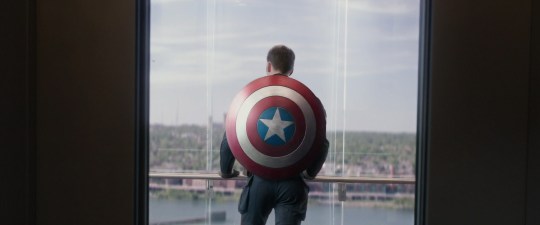
Does it pass the Bechdel Test?
Yes, once.
How many female characters (with names and lines) are there?
Five (29.41% of cast).
How many male characters (with names and lines) are there?
Twelve.
Positive Content Rating:
Three.
General Film Quality:
No matter how many times I watch this, I’m always surprised by how excellent it is. If any other future Marvel film wants to be ‘the best’, this is the movie it has to beat for the title.
MORE INFO (and potential spoilers) UNDER THE CUT:
Passing the Bechdel:
Natasha asks about the ballistics on the weapon used against Fury, and Maria responds. I’ve heard people argue that Natasha was not asking Maria specifically and therefore this does not count, but since Natasha clarifies a detail of Maria’s response (to which Maria responds again in order to confirm), I definitely think it qualifies. I have allowed a pass for far, far less in the past.

Female characters:
Natasha Romanov.
Peggy Carter.
Maria Hill.
Sharon Carter.
Renata.
Male characters:
Steven Rogers.
Sam Wilson.
Brock Rumlow.
Georges Batroc.
Jerome.
Jasper Sitwell.
Nick Fury.
Alexander Pierce.
Aaron.
Arnim Zola.
Senator Stern.
Bucky Barnes.
OTHER NOTES:
They start this movie by having Steve go for a jog and make a new friend, with a conversation ensuing that is by touches casual, light, humorous, insightful, serious, and sobering. It’s a pretty weird way to launch a much-anticipated superhero comic-adaptation action movie sequel, to be honest, but it’s also rock-solid character establishment - for the never-before-seen Sam Wilson, and for Steve Rogers whose mental state and coping skills in the modern era are kinda an open question at this point - and by getting us on level with Steve’s day-to-day (rather than Captain America’s, which comes after) they’ve immediately prepped us for a story in which this character confronts and reassesses who he is and what he stands for at a core level, and not just in a symbolic/legacy kind of fashion (a la Tony Stark). It may say ‘Captain America’ on the tin, but this is Steven Rogers’ story. This is a fantastic and well-condensed first three minutes of this film, before they fly off to deliver the action sequence we may well have expected to have received up-front.
Oh yeah, also this opening scene involves jogging around the Washington Monument, which is not a subtle detail, but I can dig it. If they’d had Steve draw attention to some Major American Landmark at some point in the movie and make a patriotic declaration of some kind, then I’d cry foul, but as-is the use of Washington DC as a setting is the hardest they bother to hammer the AMERICA button. The absence of self-fellating patriotism which I appreciated so much in the first film continues to be a virtue in this one. I do dig.
Remember how I really love it when people get hit and fly off the screen? Steve just kicked a dude off a boat and I made the dorkiest ‘hee hee!’ noise ever. Sure am glad the only reason anyone knows about that is that I just told y’all, and not because anyone actually heard me.
One day, we’ll stop getting these kinds of gratuitous butt shots of female characters in tight clothes. But it sure ain’t this day.
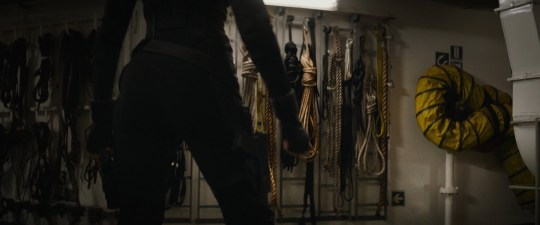
In a world of equal-opportunity sexualisation, this Cap-butt would be forgiveness enough for the aforementioned offense. But it still sure ain’t that day, friends.

Other reasons to love that opening scene: they low-balled Sam’s counseling skills to us by having him quickly identify the best way to speak to Steve and to engage with him (as Steve, again, not as Captain America; that’s the key), and that’s what allows Steve to bond with him enough that, put in a tight spot and not sure who to trust, he shows up on Sam’s doorstep later in the film. Really tight characterisation and dynamic-building.
ALSO, Steve’s adventure to the Captain America museum exhibit reminds us all of what he’s lost - specifically, Bucky Barnes - and contextualises his encounters with Sam Wilson within the emotional landscape of Steve’s desire for close male companionship, highlighting the need which compels the formation of that bond while also accentuating the sense of Steve’s present isolation and uncertainty, robbed of any understanding confidante (the bittersweet reality of having Peggy Carter still alive, but losing herself to Alzheimer's, really hits that one home). Again, Steve’s emotional landscape is actually a vital part of the story of the film on both character and plot levels, so there’s a LOT of great show-don’t-tell demonstration in the interconnections of all these scenes, PLUS they’re doing the good work for all the other characters involved AND reminding the audience of the score so that the film can continue to draw from the past as the movie continues, without losing any viewers for whom this might be the first foray into the Captain America story. This movie is just...really well put together, guys. It’s a little shocking, how good it is.
Winter Soldier intro is too cool. Not a pun.
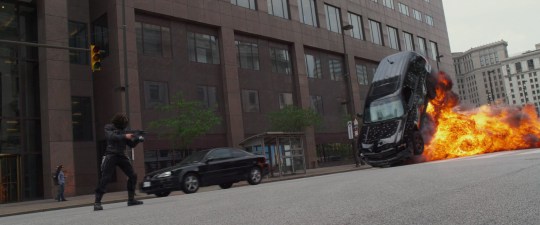
Steve takes a chance and asks his neighbour out for coffee; she declines with a soft no; he accepts even-tempered and assures her he won’t trouble her any further, and she lets him know that he’s no trouble and there’s no hard feelings. It’s all a very painless and respectful navigation of boundaries, and taken on face value (ignoring the part where she turns out to be an undercover SHIELD agent, and everything which unfolds from there), it’s a welcome example of how easy it is to take rejection graciously. Guys, be the Steve Rogers that women want to see in the world.
I want a metal arm. I don’t want to not have my current arms, they’re fine, but in an abstract version of the world where you have things purely for cool points, I want a metal arm.
The fight choreography in this film is great. It’s good watchin’.
Also the soundtrack is top-end.
“...Specimen.”
The movie didn’t need a hetero kiss thrown in there, though. I sure wish there wasn’t a random kiss in there.
“The answer to your question is fascinating. Unfortunately, you shall be too dead to hear it.”
Urgh, why Senator Stern gotta show up, be a pig about women, make his little Nazi declaration, and leave? The answer is, he really doesn’t gotta. You know what’s good shit? Not using misogyny and objectification of women to demonstrate that a bad guy is a bad guy, unless it’s actually a relevant part of the story. One day...
I can’t deal with how cool the Winter Soldier is. I’m almost embarrassed by how much the whole Silent Sauntering Assassin thing works for me.

Sam Wilson brings a tiny knife to a gunfight and still gets the upper hand because he’s perfect.
THE FIGHT CHOREOGRAPHYYYYY
The Winter Soldier is barely in the film in the first hour, and Bucky is referenced in the museum but not discussed by any of the characters, so there’s no lantern hanging on either the mystery of the Winter Soldier’s identity or the conspicuous reminder of a supposedly dead character (another reason why tying the memory of Bucky in so tightly with Steve’s present state of comfortless seclusion is important and clever). If you somehow managed not to be spoiled for it already, the Bucky reveal is a real kicker of a twist.

The degree to which I adore Sebastian Stan’s attention to detail in his performance has increased tenfold since The First Avenger. Dude has got nuances on his nuances.
The part of me that is emotionally susceptible to heroism is very moved by all the nameless SHIELD agents who stand up to HYDRA and die for it.
I join the rest of the world in being really disappointed that what appeared to be Jenny Agutter’s councilwoman kicking Strike Team ass was actually just Black Widow. Sorry Natasha.

The Winter Soldier shows up and murderises a heap of pilots, and the part of me that is susceptible to heroism finds itself in conflict with the part that is susceptible to the Winter Soldier’s ineffable coolness (which is itself at odds with the part of me that wants Bucky Barnes to be safe and happy). This movie got me good.
Rumlow talkin’ some shit about pain and Sam’s just like “Man, shut the Hell up,” and it’s perfect. I love him.

I love this film. I mean I really, really love it. Like, I mean this is one of my favourite movies in the world. Like, if we were playing that ol’ game of ‘if you had to pick ten movies, and those were the only movies you were allowed to watch for the rest of your life’, this would be one of my ten movies. That’s how much I love this film. There’s so much to get into here, so much to enjoy: it’s light and easily-digestible enough for when you just want to be entertained by something that doesn’t demand too much from you, but it also has serious depths for when you’re in the mood to dig in. It has well-crafted action scenes, but also a strong plot with powerful emotional currents. It has wonderful, charismatic actors playing intriguing characters, and most of them are good eye candy, but none of them are just eye candy - there’s a lot of complexity to unravel in the motivations and personal narratives of the leads. It’s a superhero movie, sure, but it’s also a political spy thriller. And, to top it off, it’s not only an excellent stand-alone film, it’s also a fantastic example of how to do a sequel right.

Sequel-making can be a fraught business; you’ve got sequels that are basically just pointless retreads of the original, sequels that are so different they hardly count as sequels at all, sequels that are so busy trying to be ‘bigger and better’ than the original they become ridiculous, sequels so busy attempting to capitalise on the spectacle of the original that they forget to have any of the same heart that gave the original meaningful impact, sequels that ignore that the original had a plot and themes and that maybe that stuff was relevant to its success, etc, etc...there are lots of great sequels in the world, certainly, but as Iron Man 2 and Thor: The Dark World already attested for the MCU, it is very, very easy for sequels to go wrong. For this film, I think it goes without saying that I feel they passed all of the above sequel-killing quality tests with flying (low-key red-white-and-blue) colours, hence my adoration. But, just for kicks, lets talk about how they did it.
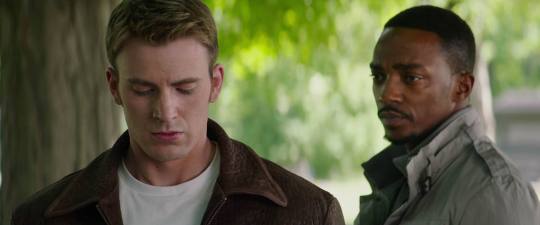
For starters, you can pretty much guarantee that this isn’t gonna be a pointless retread of Captain America: The First Avenger, since this movie takes place seventy years later and there are certain essential world elements that have fundamentally changed, such as technology, characters, and the fact that WWII ended a good while previous. But, that’s exactly how they make this story work as a sequel: they use the nature of change to give the film its shape, thematically, politically, emotionally, and in doing so they assure that everything which is different in the present builds directly from the past. Steve Rogers has not fundamentally changed, and that’s a critical anchor, considering he’s the titular character and all, but he is in a state of flux due to everything else that has changed, and his doubts inform the narrative landscape. This is not the world he remembers, and yet, as the plot unfolds and he digs into the conspiracy at his feet, there’s plenty there that is hauntingly familiar, because this is a story about how the past is still alive and kicking in the present, it has just updated to keep with the times.

It’s worth noting that despite Captain America making the jump from the forties to the modern age without any stop-offs in between, the film doesn’t linger on or wallow in the differences in his world in any strict sense - even Steve himself (in that EXTREMELY well-crafted opening scene with Sam) is somewhat dismissive of the specifics, because he’s not dwelling on the oh-woe-things-have-changed, he’s just trying to get his head around it, adapt, and move forward (and the practical realities are easy enough, but the emotional facets? Yeah). The thing is of course, no one else shares this problem with Steve; they’ve all been around, variously, for the parts in between, and the story is still concerned with the context of the world which made all of its characters what they are, and particularly with the war that came after WWII, the war within which HYDRA reseeded and began to grow anew: the Cold War. In particular, it’s the ‘70s/’80s era Cold War, built into the political-thriller superstructure of the film itself and driven home most overtly by the Winter Soldier, heavily Russian-coded and steeped in the potent psychological horror of brainwashing, but there are other signifiers littered across the story as well. There’s former-KGB agent Black Widow, and the reference she makes to WarGames, and there’s Arnim Zola frozen in time by the ancient computer system which now acts as his ‘brain’, and then there’s the stroke of subversive genius in the casting of Robert Redford - the positively Captain America-esque blue-eyed-blond hero of many a seventies Cold War political thriller - as our primary villain, working within the United States government for the benefit of his secret European-originating agenda in true foreign-infiltration style. Of course, we can adapt all of this to fit the radicalised terrorism and technological paranoia of modern times (and those elements are alive and well in the text with the surveillance-state fears represented by the helicarriers), but the historical timestamping is important to the trajectory of the film; times change and things grow increasingly subtle and complicated, but the core dilemmas that call people out to fight are instantly familiar. In that sense, Steve Rogers hasn’t missed much at all.

The war that calls Cap to arms this time around may be more subtle than the openly-fought battlefields of WWII, but it is no less global or insidious; the new ‘improved’ HYDRA may not be led by a literal Nazi who peels off his own face, but the cold political calculations of Alexander Pierce are much more frightening for their realism (an aspect of the film which has become increasingly prescient for the modern era since the movie was released), and the fascist supremacist dogma that compels these villains to attempt to reshape the world with the blood of millions is drawn from the same poisoned well; this is an escalation of the same enemy that Captain America faced before, only much closer to home. And while the passage of time has benefited the old evils in allowing them to entrench and fester and craft re-branded, more socially-accepted versions of themselves, it has not been so favourable to the positive familiar things from Steve’s past: it has claimed Peggy’s memory, and rotted SHIELD beyond recovery. And then, there’s what it’s done to Bucky Barnes.

Fake-out character deaths are a major staple of the superhero/comic genre, and not one I love, since it tends to take the power out of apparent-death scenes and leaves the drama feeling contrived, and while the Bucky reveal is not entirely free from that cynicism, it sells itself well on delivery. For starters, it packs a wallop in additional drama instead of just neatly undoing that which already existed (Nick Fury’s ‘death’ and reveal, on the other hand, is more in the classic line of cheap and inconsequential), and it ups the personal stakes for Steve in exactly the same way as Bucky’s ‘death’ did in The First Avenger. Crucially, the fact that Bucky is the Winter Soldier doesn’t alter the wider narrative in any convenient way, such as providing Captain America with the key to stopping him or resolving the other conflicts of the plot through his connection; the Bucky reveal reconnects the story to Steve’s emotional journey, which is exactly where it started before Shit Got Crazy - there’s a good reason they spent the first half hour of the movie on charting Steve’s mental state. There’s a sharp division between Bucky Barnes and the Winter Soldier, despite them both inhabiting the same form, and it’s a mirror of the division between Steve Rogers and Captain America: regardless of all assumptions to the contrary, the two are mutually exclusive entities. ‘Captain America’ is not a person, he’s a symbol, and he’s manipulable in that way, he can be propagandised, his image and actions are a tool turned to the purposes of others at the expense of the human underneath; Steve recognises this (and has since the first film), and he holds this secondary persona at a remove and does not define himself through it. This is what Sam’s keen social instincts pick up so quickly in the beginning: treating Steve as Captain America is the wrong approach, it fails to connect, because Steve is not the uniform, Steve has doubts, Steve could give up the shield; Steve is a person. Bucky doesn’t have the same luxuries, in opportunities, in company, or in the cognizant ability to define his own identity, but even without the personal attachment of their history, Steve is uniquely positioned to understand the difference between the Winter Soldier and the person buried beneath the title. If it was not Bucky, specifically, the visceral emotion of the mirrored experience wouldn’t land quite as strong, but either way the Winter Soldier is the realisation of Steve’s deep-seated fear of being made a puppet, an unthinking enforcer too heavily indoctrinated into patriotic subservience to recognise the despotism that has replaced his idealism.

I said at the top that this is, ultimately, a Steven Rogers story to which ‘Captain America’ is an accessory, and not the other way around, and that’s a fact at the heart of what makes this film work - on its own, and as a sequel. The fore-fronting of Steve as a character in his own right and not just ‘Captain America’s real name’ was key to avoiding any cloying patriotism overriding the narrative of the first film, and it’s doubly important now as both Steve and the Captain America brand re-situate outside of their original context. It’s easy to strip back the specific trappings of Captain America and still have this movie function just right, because for all the action and intrigue, it is essentially a character piece about Steve Rogers figuring out his place in the world and reclaiming the moral compunctions which have been presumptuously attributed to the lofty symbol of his alter ego, and not the struggling reality of everyday life. Captain America is what he is and how he is not because it sounds good or because it makes for positive PR or because it’s nice to have legends from the good ol’ days; Captain America is the embodiment of scrappy little Steve Rogers’ grit and determination to live up to what he believes in, come Hell or high water or the gravest of consequences. Steve begins the film at odds with himself, unsure if there’s a place for his shameless idealism within the mess of modern life; he’s going through the motions of being Captain America, but he’s uncertain of what it means to him at this point, or where it’s headed. He finishes the film having gained something vital: a mission, but it’s not a professional job for Captain America, it’s a personal mission for Steve Rogers, and that’s much more important. Captain America is just an idea; Steve Rogers is the reason it matters, no matter what war, what time, what place, or what flag.
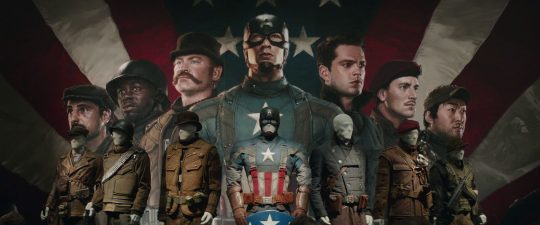
#MCU#Marvel Cinematic Universe#Captain America: The Winter Soldier#Bechdel Test#female representation
17 notes
·
View notes